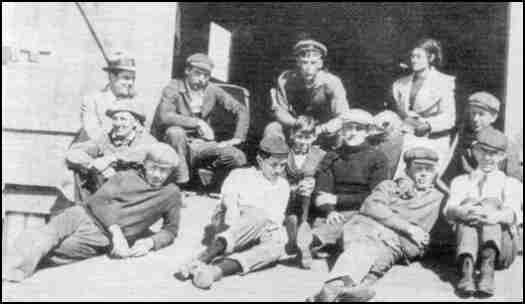
-1936 |
 |
Carl Adams, Beck, Walker, Mrs. Beck, Ellyson, Witmer and Robinson. US Naval Historical Center, collections of T.G. Ellyson and J. L. Callan From WALDO: Pioneer Aviator |
|
Shortly before Curtiss left North Island, Witmer and Cooper assembled an aeroplane from the mass of parts lying around the camp. We named her Lizzie. She had a Curtiss 50-hp 4" x 4" engine, double-surface wings and, initially, the Curtiss butterfly tail and single-surface front elevator. However, following those day's 'cut and fit' methods, the front elevator was soon eliminated, simply leaving the outriggers and crossbar, which then came in handy as a level reference. As you looked forward, it would give you your relative position to the horizon, indicating if your were slipping, climbing or descending. It was a complete attitude instrument in one very simple device. In Mid-May, Witmer and Cooper headed "Back East", Lizzie was dismantled stored in a hangar, and the keys were given to Waldo. But Witmer and Cooper weren't together long - by the time they reached St. Louis, Cooper had been enticed away by another exhibition flyer. |
|
The star of the meet was to be Walter Brookins. A number of other aviators were scheduled to appear at the Fairgrounds; Andrew Drew and Tom Benoist of St. Louis, John D. Cooper, Charles Zornes, Sax Ganz, C.O. Prowse, and Hillery Beachey, the brother of Toledo aeronaut who had flown dirigibles in St. Louis in 1907 and 1909. In addition, several pupils from Tom Benoist's flying school intended to exhibit their fledgling talents; Harry Rafferty, John Woodlief, Alfred Boullet, B.N. Elsk, and Charles Griffin. Contests for rapid starting, speed, altitude, target bombing, and accurate landing were planned, as well as the usual aerobatics by all participants. The Aero Club of St. Louis scheduled a broader tournament for October 14-21 at Kinloch Park, its permanent aviation field. On September 5, 1911, Albert Bond Lambert signed an agreement with A. Roy Knabenshue, manager of the Wright Company, whereby the Wrights would supply three pilots and biplanes in return for 25 perecent of the gross receipts of the meet. The three aviators -- Howard Gill, J. Clifford Turpin, and P.O. Parmelee -- were to fly every day but October 15, because of the rule of the Wright Company against Sunday flights. Also entered were Dr. Henry Walden of Mineola, Long Island, with his picturesque Antoinette monoplane; Amedee V. Rayburn Jr. of St. Louis with his Bleriot monoplane; Horace Kearney and John D. Cooper of St. Louis with Wright biplanes; George Beatty; and Walter Brookins. The History of Aviation in St. Louis |
|
From The Early Birds of Aviation Roster, 1996 |
|
Recommended Further Reading:
WALDO: Pioneer Aviator A Personal History of American Aviation, 1910-1944 by Waldo Dean Waterman with Jack Carpenter Arsdalen, Bosch & Co. CITY OF FLIGHT The History of Aviation in St. Louis by James J. Horgan The Patrice Press, 1884 |


|